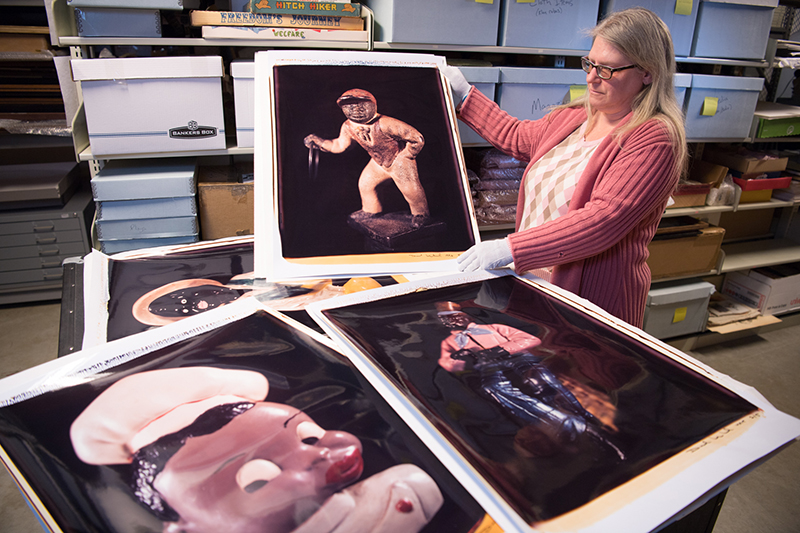
PHOTO CAPTIONS: Above is Jim Crow Museum Assistant Lisa Kemmis displaying artwork
from noted photographer David Levinthal. The Ferris State University museum received the powerful collection of artwork valued at more than $2 million, pending
receipt of appraisal. Below is a photo of David Pilgrim, founder and curator of the
Jim Crow Museum.
The Jim Crow Museum of Racist Memorabilia at Ferris State University has received a powerful collection of artwork by noted photographer David Levinthal valued at more than $2 million, pending receipt of appraisal.
The gift, from an anonymous donor, includes 135 large-format Polaroids, primarily
from  Levinthal’s legendary Blackface series, but complemented with works from his Barbie and Mein Kampf series.
Levinthal’s legendary Blackface series, but complemented with works from his Barbie and Mein Kampf series.
With this donation, it is believed that the Jim Crow Museum of Racist Memorabilia, which is internationally-known for its collection of racist memorabilia, now possesses one of the largest collections of Levinthal’s Blackface originals in the world.
Museum officials have catalogued all of the items and are preparing many for public exhibition. A grand opening event is expected to occur in December.
After being contacted by the donor’s representative, David Pilgrim, vice president for Diversity and Inclusion at Ferris and founder and curator of the Jim Crow Museum, immediately knew the magnitude of the impact this gift would bring to the Museum and all who visit.
“Levinthal’s Blackface series is a blunt, unfiltered rendering of anti-black representations in the objects once—no, still—found in our homes,” Pilgrim said.
“He used his camera to document the ugly representations of African Americans in the toys, games, and dolls played with by this nation’s children. These images both reflected and shaped attitudes toward black people. Levinthal’s prints will be invaluable teaching tools for the Jim Crow Museum,” Pilgrim added.
The Blackface series is a powerful and thought-provoking exhibition of black memorabilia and racist household objects, many of which are currently collected and displayed as part of the Museum’s educational and scholarly mission to use objects of intolerance to examine expressions of racism and promote social justice.
“This wonderful gift to the Jim Crow Museum and Ferris is one of the most significant gifts that we have ever received,” said Ferris President David Eisler.
“This gift reflects Dr. Pilgrim’s internationally-recognized leadership and commitment to educating the public on examining expressions of racism and promoting social justice,” Eisler noted.
Aside from the Blackface series, the Museum also acquired notable pieces from Levinthal’s equally impressive Barbie and Mein Kampf series, which Museum officials are eager to display.
“Like the Blackface series, Levinthal’s prints from the Barbie and Mein Kampf series will help the Jim Crow Museum—and its companion facility, the Museum of Sexist Objects, explore sexism and other forms of oppression,” said Pilgrim.
“Receiving a gift of this size demonstrates the unmatched significance that the Jim Crow Museum of Racist Memorabilia has on our society. We are grateful for donors such as this who choose to help us in this endeavor to educate and inform,” added Bob Murray, associate vice president of Advancement at Ferris.
The gift of Levinthal’s work to the Jim Crow Museum has already started to become known by researchers and scholars.
“David Levinthal’s provocative Blackface photographic prints belong in the Jim Crow Museum, a public space that daily critiques demeaning and debilitating stereotypes of African Americans,” said Henry Louis Gates, Jr., director of the Hutchins Center for African and African-American Research at Harvard University.
Levinthal, who has received a Guggenheim Fellowship and a National Endowment for the
Arts Fellowship, has works included in numerous museum collections including the Whitney
Museum of American Art, the Museum of Modern Art, The Metropolitan Museum of Art,
the Gene Autry Western Heritage Museum, and The Menil Collection.
About Jim Crow Museum
The Jim Crow Museum of Racist Memorabilia at Ferris State University, Big Rapids, Michigan, displays a wide variety of everyday artifacts depicting the history of racist portrayals of African Americans in American popular culture. The mission of the Jim Crow Museum is to use objects of intolerance to teach tolerance and promote social justice. The Jim Crow Museum of Racist Memorabilia has a collection of more than 10,000 objects, primarily created between the 1870s and the 1960s. It also includes contemporary objects. The museum demonstrates how racist ideas and anti-black images were pervasive within American culture. It also shows how these images and ideas have resurfaced in recent years. Stories about African-American achievements during the Jim Crow era, along with artifacts of the Civil Rights Movement, are also found within the museum.
About Ferris State University
Ferris State University is a four-year public university with campuses in Big Rapids, Grand Rapids and satellite campuses across the state of Michigan. Ferris offers more than 180 educational programs, including doctorates, master’s, bachelor’s and associate degrees, through eight academic colleges: Arts, Sciences and Education, Business, Education and Human Services, Engineering Technology, Health Professions, Kendall College of Art and Design, Michigan College of Optometry and Pharmacy.
About David Levinthal
David Levinthal (born 1949) is a photographer who lives and works in New York City. He uses small toys and props with dramatic lighting to construct mini environments of subject matters varying from war scenes to voyeurism to racial and political references to American pop culture. He was the recipient of a Guggenheim Fellowship from the John Simon Guggenheim Memorial Foundation in 1995 and a fellowship from the National Endowment for the Arts in 1990–1991,
His work is included in the permanent public collections of the Art Institute of Chicago, the Centre Pompidou in Paris, the Corcoran Gallery of Art in Washington, D.C., the Los Angeles County Museum of Art, the Metropolitan Museum of Art, the Museum of Modern Art, and the Whitney Museum of American Art in New York City. He has had solo exhibitions in New York City, Los Angeles and Portland, Oregon.

